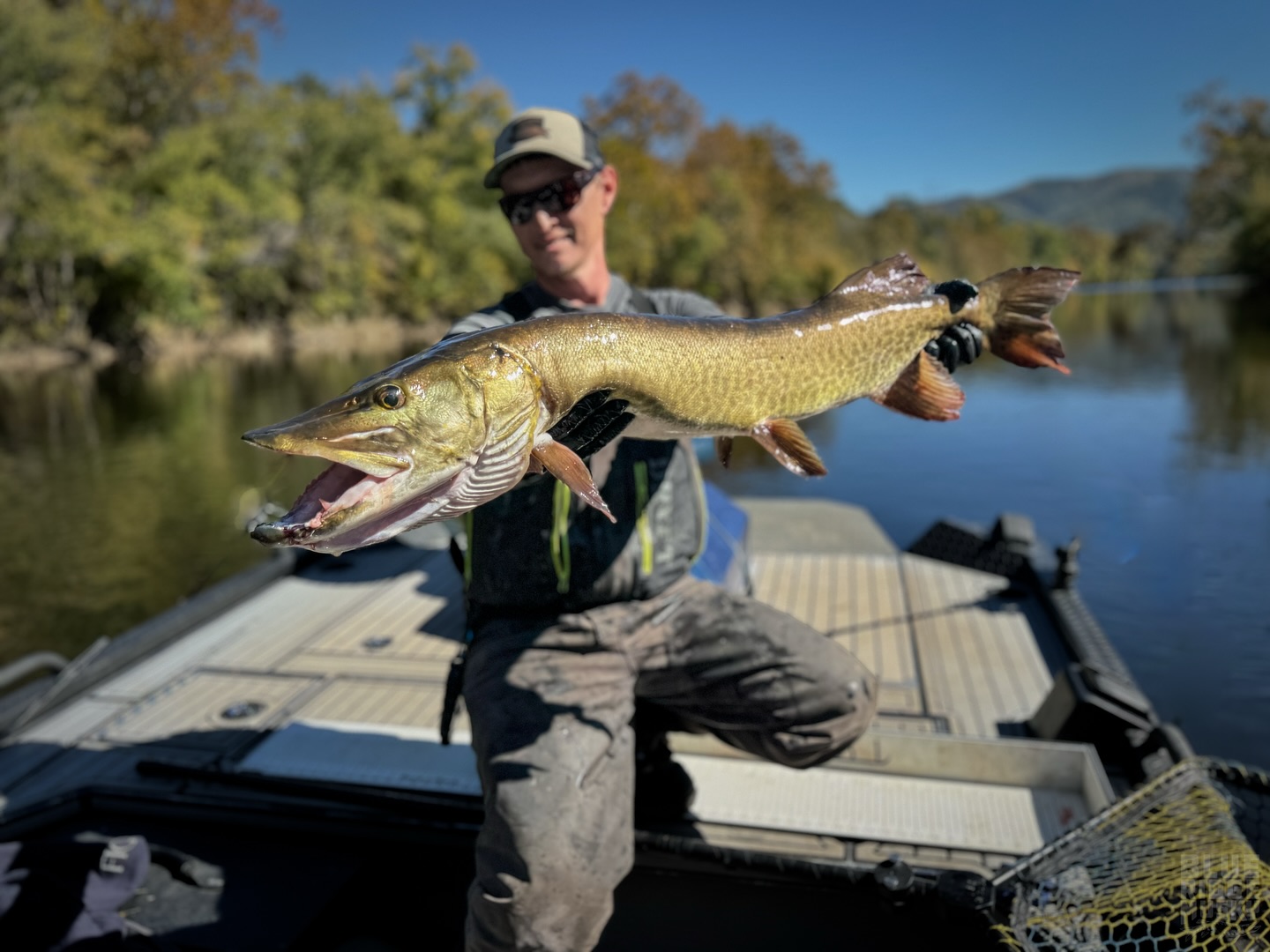Rivers are like mystical soul balm. You apply just a little bit and the results are amazing. Get on a little river that flows through the country side past farmland and forest. Listen carefully and you will hear those magic words that sooth the deepest fears and worst travails. Even big rivers
with mile wide expanses and humming industrial plants can allow the well
known to loose themselves up a creek, the little known to feel like the first to turn a river bend.
These are fragile systems, their health often reflective of how important it is to us to protect our natural resources and ultimately ourselves. We love them, cannot live without them, but we often abuse and overuse them.
May marks the start of river fishing season for many in the region. Some you use jon boats, others kayaks and canoes. Jet boats are another option for the bigger rivers. Wading is fine, too. No matter the method, rivers are plentiful and productive around the Commonwealth.
Each year Woods & Waters compiles a list of the top rivers in the state for fishing. Some are small and best suited for float fishing. Others are plenty big enough for a 250 hp powered bass boat. Some are fresh and some are slightly salty. We hope you enjoy exploring these special rivers. We ranked them based on Virginia Department of Wildlife Resources trophy fish numbers as well as uniqueness, accessibility and natural beauty.
Here are our top rivers for 2025.
The New River
The New River is an ancient river system, the oldest on the North American continent and second only to the Nile River in Africa as the oldest river in the world. It begins as two streams in the Blue Ridge Mountains of North Carolina, before merging into the New River four miles from the Virginia line. And therein lies another quirk of this ancient river – it flows northward rather than southward like most of the other major rivers along the eastern seaboard. It meanders some 160 miles through the counties of Grayson, Carroll, Wythe, Pulaski, Montgomery and Giles in Virginia before it turns into Bluestone Lake in West Virginia and emerges later as the Kanawha River at the Gauley Bridge. The New River ends its metamorphosis when it empties into the great Mississippi River.
Fishing is not to be missed in on the New River as it is one of the best, if not the best fishing rivers in Virginia. The New supports outstanding populations of just about every major freshwater game fish in the state: smallmouth bass, spotted bass, largemouth bass, rock bass, striped bass, hybrid striped bass, muskellunge, walleye, black crappie, channel catfish, flathead catfish, yellow perch, redbreast sunfish, and bluegill.
State records caught from the New River include muskellunge (45 lbs. 8 oz.), caught June 1, 2007, smallmouth bass (8 lbs. 1 oz.), caught March 12, 2003, and walleye (15 pounds, 15 ounces), caught December 15, 2000. Claytor Lake, a mainstem New River reservoir, yielded the state record spotted bass (4 pounds, 12 ounces), caught January 1, 2020, and the state record hybrid striped bass (15 pounds, 13 ounces), caught March 16, 2016.
Virginia Department of Wildlife Resources(VDWR) biologists separate the New into two sections; above Claytor Lake and
below. According to recent surveys, the section above Claytor is teeming
with walleye. This thanks in part to a native species and stockings by the
Virginia Department of Wildlife Resources. There is a 20” minimum
size limit on the ‘eyes here. Below Claytor Lake (remember the New flows
north), there are plenty of smallmouth thanks to the best spawns ever
recorded in ‘04 and ‘05.
Total Citations – 5, Uniqueness – 4, Accessibility – 4, Natural Beauty – 5
Total Score – 18
Tidal Chickahominy River
With broad expanses of open marshes, lily pads, lush aquatic grasses and cypress trees along much of its shoreline, and a diversity of fish species to choose from, the Chickahominy River provides the angler with tidal river fishing at its finest.
This river supports a nationally recognized largemouth bass fishery, and in recent years anglers have been reporting excellent bass fishing in the tidal Chickahominy. Generally, anglers can expect good numbers of largemouth in the one to three-pound range, with a few largemouth weighing over five pounds. This fishery is characterized by high angler catches. Of all Virginia tidal rivers, the tidal Chickahominy typically has the highest largemouth catch rates.
Yellow perch, white perch, and black crappie all provide excellent fishing. Yellow perch can be found along the edges of “grass beds”, whereas crappie fishing is best around structure on steep channel drop-offs.
Access to the tidal Chickahominy is good using a series of marina-owned ramps beginning just below Walker’s Dam at Rockahock Campground, then Riverside Camp & Marina, River’s Rest, Midway Marina and then Chickahominy Waterfront Park. There is also a DWR ramp in the back of Morris Creek.
Total Citations – 3, Uniqueness – 4, Accessibility – 4, Natural Beauty – 4
Total Score – 15
Upper James River
From the junction between of the Jackson and Cowpasture Rivers in Botetourt County, downstream until the 14th Street bridge in Richmond, the 250-miles of non-tidal James River offers a wide range of angling opportunities and settings. Smallmouth bass are the most common game species, but spotted and largemouth bass can also be caught.
Beginning at the confluence of the Jackson and Cowpasture Rivers near Iron Gate, the upper James River flows approximately 90 miles downstream to the City of Lynchburg. Smallmouth bass, muskie, catfish, rock bass, and other sunfish species provide diverse fishing opportunities to anglers on the upper James River.
The middle James River consists of the 130-mile portion of the river between Lynchburg and Bosher’s Dam just upstream from Richmond. The middle section of the river consists of a series of shallow rocky riffles and slow deep pools. The middle river offers modest smallmouth bass action, fair numbers of sunfish, and an abundance of catfish.
In recent years favorable adult catch rates have been limited to the upper middle river in the area of Bent Creek. In 2022 several areas showed noticeable improvements with Bent Creek, James River WMA, Howardsville, Hardware River, Bremo Bluff/New Canton, and Westview all surpassing the historic average catch rate for adult smallmouth.
Anglers have enjoyed excellent musky fishing on the upper James in recent years due to careful management and stocking by the DWR.
Total Citations – 4, Uniqueness – 3, Accessibility – 4, Natural Beauty – 4
Total Score – 15
The Shenandoah River
The main stem Shenandoah River is formed when the North Fork and South Fork converge at Front Royal, Virginia. The Shenandoah flows for 57 miles until it empties into the Potomac River at Harpers Ferry, West Virginia. The section of the Shenandoah which will be discussed is the 35 miles of river that lies within the state of Virginia. The section of the Shenandoah flowing through Clarke County is designated as a state scenic river. The Main Stem Shenandoah is a sixth order stream and averages around 150 feet in width.
The Shenandoah is typically a low gradient river, but there are some class I rapids produced at riffle areas. The substrate of the river varies from bedrock and boulders to cobble and gravel. Several species of rooted aquatic vegetation are found in the shallower regions of the river. This vegetation can become quite dense during the summer months.
Serious smallmouth anglers know the Shenandoah River is one of the top smallmouth bass rivers in the eastern United States. Densities of smallmouth are not as high in the Main Stem as they are in the North and South Forks of the Shenandoah. Smallmouth bass catch rates can average up to two fish per hour. Fisheries biologists consider catch rates greater than one fish per hour to be very good. Remember, fishing success can vary depending upon environmental conditions. While densities of smallmouth bass are lower on the Main Stem Shenandoah than the North or South Forks, growth rates are better and larger fish are more common. The natural mortality rate of smallmouth bass in the Shenandoah is high and harvest by anglers is low, based on research conducted by biologists. Therefore, the smallmouth bass population is mostly controlled by environmental influences (floods/droughts).
The VDWR annually stocks fingerling-size musky at several sites on the Main Stem Shenandoah River. There has been no evidence of muskies reproducing naturally in the Shenandoah river, therefore they must be stocked to sustain a fishery. Adult musky densities are low and closely resemble numbers seen in a wild, reproducing population. The area directly downstream of Warren Dam is the best location to connect with a musky on the Main-stem Shenandoah.
Densities of smallmouth bass in the South Fork Shenandoah River are greater than any other river in Virginia. Smallmouth bass catch rates can average up to four fish per hour. It is not uncommon for experienced anglers to catch 30-60 smallmouth during a eight hour float trip. Fishing success can vary depending upon environmental conditions.
The South Fork Shenandoah may be known for its high catch rates of smallmouth bass , but it does not produce the number of trophy-size smallmouth bass as other Virginia waters. Growth rates are extremely slow with smallmouth not reaching twelve inches until age 5-6.
Total Citations – 3, Uniqueness – 3, Accessibility – 4, Natural Beauty – 4
Total Score – 14
Nottoway River
The Nottoway is a Virginia Department of Conservation and Recreation designated state scenic river, with a minimum of development and good fishing for a variety of species. It begins in Nottoway County, meanders 130 miles through the Commonwealth’s piedmont and coastal plain then, at its confluence with the Blackwater River, forms the Chowan River in North Carolina.
The Nott is s a diverse fishery, ranging from bass (both largemouth and smallmouth) and catfish to shad and herring. Panfishes, including bluegill, redbreast and redear sunfish, Roanoke bass, yellow perch, and black crappie are also common. The Nottoway produces some trophy fish, primarily redear sunfish and blue catfish.
Fishing for shad and herring can be excellent in March, April, and May, as they run up from the Chowan. The Roanoke bass (more commonly known to locals as “rock bass” or “redeye”) is a species of special concern in Virginia. Only a few rivers have them, but the Nottoway has quite a few with fish over one pound common. They are generally found upriver in the summer and down river in the winter. A few smallmouth bass are found throughout the river, with more fish found upstream. The Southampton County portion has most of the big redear sunfish.
Public boat ramps are numerous. Above the Route 619 bridge on the Greensville-Sussex County line, the river is generally shallow, clear and fast flowing with smallmouth and spotted bass. There are numerous small rapids that prevent the use of outboard motors and large boats, but canoeists will find some nice float trips.
Below Route 619, the river slows, deepens, and darkens as numerous swamps in the coastal plain join it. This part of the river, particularly in Southampton County, is large enough for bass boats during normal flows.
Below Cortland the Nottoway changes to a blackwater river and is full of fish species including largemouth bass, spotted bass, Roanoke bass, red ear sunfish, perch, striper and more.
A popular put-in for small boat anglers is the VDWR Hercules boat ramp just off General Thomas Highway. Bass boat owners will want to use the General Vaughan Bridge boat ramp off Smiths Ferry Road.
Total Citations – 5, Uniqueness – 3, Accessibility – 3, Natural Beauty – 3
Total Score – 14
The Maury River
Traveling interstate 81, you get a quick look at the Maury River just north of Lexington as it passes beneath a bridge underneath your wheels. If you’re traveling U. S. 11 instead of the interstate, you get a more intimate look at the river. But neither perspective gives you a true picture of this fast mountain stream that offers so much to so many outdoorsmen.
The Maury River is fairly short by most standards. From the confluence of the Calfpasture and the Little Calfpasture Rivers, it’s approximately 30 miles to its confluence with the James River. En route it brushes the charming cities of Lexington and Buena Vista.
The best fishing is in a stretch just north of
Lexington down to Glasgow. This roughly 30-mile stretch was sampled recently
by the VDWR and the results were surprising. In some stretches, biologists
recorded an amazing 350 smallmouth per mile over 11”. Many of the fish were
over 17”. This says a lot for this small river.
While the trout fishing in the upper Maury is seasonally popular, the smallmouth bass and sunfish in the lower river hold more appeal for many anglers. Anglers can catch a smallmouth bass anywhere from the headwaters where the Calfpasture and Little Calfpasture join to form the Maury, to the mouth of the river where it enters the James. Anglers frequently catch smallmouth bass while fishing the Goshen Pass waters for trout, but the best fishing begins downstream where the Pass waters become more gentle.
An ideal bass and sunfish trip might begin at the Glen Maury Park launching area in Buena Vista and end at the Department of Wildlife Resources’ Locher Landing near Glasgow. This is a 12-mile run and even a long summer day won’t give you enough time to fish all of it.
The Maury River is also loaded with yellowbreast sunfish. In addition to the bass and sunnies the Maury holds populations of rock bass, another stream mate of smallmouth bass in the western part of the state. Total Citations – 3, Uniqueness – 3, Accessibility – 3, Natural Beauty – 4
Total Score – 13
North Fork Holston River
From its origin in the southeast corner of Bland County, the North Fork of the Holston River flows more than 100 miles through Southwest Virginia before crossing the Tennessee State line near the community of Yuma. The river boasts an outstanding smallmouth bass population, and supports populations of many other fish species.
From the town of Saltville downstream there is an exceptional smallmouth bass fishery in this southwestern Virginia river. Anglers routinely catch smallmouth up to five pounds. Sunfish, rockbass, carp, and channel catfish fishing is also good.
There is a 20-inch minimum size limit for smallmouth bass in the North Fork Holston River from the Route 91 Bridge, upstream of Saltville, downstream to the Tennessee State line. All smallmouth bass less than 20 inches must be released. One smallmouth larger than 20 inches may be kept per angler per day. This regulation was enacted to protect and enhance the trophy smallmouth fishery that has developed in this river.
Total Citations – 3, Uniqueness – 4, Accessibility – 2, Natural Beauty – 4
Total Score – 13
Staunton River
The Staunton River is located in south-central Virginia and forms the boundaries of Campbell, Pittsyvania, Halifax and Charlotte counties. Actually an 81-mile segment of the Roanoke River, the Staunton River begins at Leesville Dam and continues to the confluence with John H. Kerr Reservoir. Canoeists can experience the challenging Fish Trap (Class III) and Cat Rock (Class II) rapids. Large sections of the Staunton River also are accessible to motorboats.
This river note is one of the few
anglers can catch the ‘Hat Trick’ of bass species; smallmouth, largemouth
and spotted bass.
From Leesville Dam downstream to the headwaters of Kerr Reservoir, the Staunton River offers 81 miles of diverse fishing opportunities.
Over the past 30 years or so the Staunton River fishery has undergone some striking changes based on the flow regime from Leesville Reservoir.
Peaking flows were discontinued in 1988 and the fish undoubtedly benefited from the stabilized flow regime.
The area from Leesville Dam to Brookneal has a higher gradient, stretches with plenty of braided river channel, and a better ratio of riffles:runs:pools. For anglers, this equates to excellent habitat for smallmouth bass, saugeye and walleye.
From Brookneal downstream to its confluence with the Dan River, the Staunton River has less rocky habitat, is wider and has a predominantly sandy bottom. Habitat is abundant along the riverbanks in the form of fallen trees. Smallmouth, largemouth and spotted bass are still found in this area, but densities are generally lower.
During April and May, this section of the Staunton River is full of striped bass making their spawning run out of Kerr Reservoir.
Total Citations – 3, Uniqueness – 3, Accessibility – 3, Natural Beauty – 3
Total Score – 12
An excellent resource when planning your trip would be a Virginia Gazeteer Map Book by Rand. The VDWR website also has good information and maps for floats on many of these rivers.



